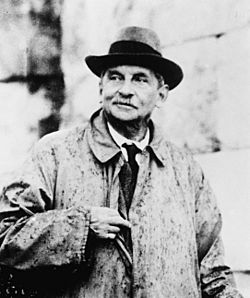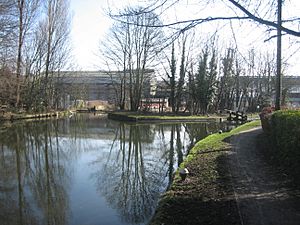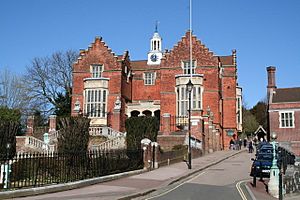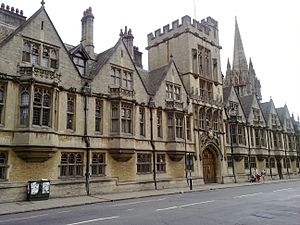Arthur Evans facts for kids
Quick facts for kids
Sir Arthur Evans
|
|
|---|---|
 |
|
| Born | 8 July 1851 Nash Mills, Hertfordshire, England
|
| Died | 11 July 1941 (aged 90) Youlbury, Oxfordshire, England
|
| Nationality | British |
| Alma mater | University of Oxford |
| Known for | Excavations at Knossos; developing the concept of Minoan civilisation |
| Awards | Fellow of the Royal Society, knighted 1911 |
| Scientific career | |
| Fields | Archaeology, museum management, journalism, statesmanship, philanthropy |
| Institutions | Ashmolean Museum |
| Influences | John Evans Heinrich Schliemann< Edward Augustus Freeman William Gladstone |
| Influenced | V. Gordon Childe; all archaeologists and historians of the ancient Aegean region |
Sir Arthur John Evans (8 July 1851 – 11 July 1941) was a British archaeologist. He was a pioneer in studying the ancient Aegean civilization during the Bronze Age. He is most famous for digging up the palace of Knossos on the Greek island of Crete.
Based on the buildings and items he found, Evans realized he needed to tell the difference between the Minoan civilization and Mycenaean Greece. He was also the first to identify Cretan writing systems called Linear A and Linear B. He also found an even older picture-based writing.
Contents
Arthur Evans's Early Life and Family
His Family Background

Arthur Evans was born in Nash Mills, England, on July 8, 1851. He was the first child of John Evans and Harriet Ann Dickinson. His mother's father, John Dickinson, owned a paper mill.
Arthur's father, John Evans, came from a family of educated people. He was not rich or from a noble family. John Evans started working at his uncle's paper mill in 1840. He married his cousin, Harriet, in 1850. This made him a junior partner in the family business. The money from the mill later helped pay for Arthur's digs and projects in Knossos.
John Evans became well-known for his interest in coins, geology, and archaeology. He loved collecting ancient items, especially Stone Age tools. As Arthur grew up, he helped his father find and sort these artifacts. John Evans became a respected expert in ancient history. He published many books and articles. His advice was very important for Arthur's career.
Arthur's mother, Harriet, died in 1858 when Arthur was seven. He had two brothers, Lewis and Philip, and two sisters, Harriet and Alice. He always got along well with all of them. He was raised by his stepmother, Fanny, whom he also liked very much. His father's third wife, Maria, was a classical scholar. They had a daughter, Joan, who became an art historian. John Evans died in 1908 when Arthur was 57.
Arthur Evans's Education
Learning at Harrow School
Arthur went to Harrow School in 1865 when he was 14. He was a co-editor of the school newspaper in his last year. At Harrow, he was friends with Francis Maitland Balfour. They both loved sports like riding, swimming, and mountain climbing. Arthur had poor eyesight but refused to wear glasses. He could see small details up close better than most people. But things far away were blurry. He used a cane to help him explore.
Studying at Oxford University
Arthur started at Brasenose College, Oxford, in 1870. He studied modern history, but his main interests were archaeology and classical studies.
His summer trips with his brothers and friends were very important for his future career. In 1871, he and Lewis visited Hallstatt, where his father had dug before. They also went to Paris and Amiens. The Franco-Prussian War had just ended. Arthur and Lewis looked for Stone Age tools in gravel pits.
In 1872, he and his brother Norman traveled into Ottoman lands in the Carpathian Mountains. This area was already tense. They crossed borders illegally and carried revolvers. This was Arthur's first time meeting Turkish people and seeing their customs. He even bought a set of Turkish clothes. His exciting story was published in a magazine in 1873.
In 1873, he and Balfour explored Lapland, Finland, and Sweden. Everywhere he went, he took many notes and drew pictures of people, places, and artifacts.
Arthur finished his studies at Oxford in 1874. He almost failed his final exams in modern history because he knew more about ancient history and archaeology. However, one of his examiners, Edward Augustus Freeman, recognized his talent. Freeman and other teachers helped him pass and get a good degree.
Time at Göttingen University
In 1875, Arthur went to the University of Göttingen in Germany for a summer term. On his way, he found some tombs being robbed in Trier. To save some artifacts, he quickly hired a team to dig and sent the items home to his father.
Arthur did not like Göttingen. He found his living space stuffy and the topics boring. He decided not to stay. He left to meet his brother Lewis for another trip to the Balkans. This was the end of his formal education.
Arthur Evans's Career
Adventures in the Balkans
Exploring Old Herzegovina
After leaving Göttingen, Evans and Lewis decided to travel in the Ottoman Empire region of Herzegovina. This area was in a state of rebellion. Christians were fighting against the Muslim rulers. The Ottoman troops were using irregular forces, called Bashi-bazouks, who were known for their cruelty. This made many in Britain, including W. E. Gladstone, turn against the Ottoman Empire.
Arthur and Lewis had some trouble with the Austro-Hungarian Empire, which was a neighbor. They were arrested and spent a night in a cell because officers thought they might be Russian spies. Arthur argued loudly, even threatening the authorities with the British fleet! They were released the next day with apologies.
They then crossed into Bosnia. Arthur found it so different that he called the Sava River the border between Europe and Asia. They traveled to Sarajevo and then to Dubrovnik on the coast. In Sarajevo, they met Edward Augustus Freeman again, who was helping the British Prime Minister keep an eye on the situation.
Reporting for the Manchester Guardian
Back home, Evans wrote about his travels in a book called Through Bosnia and Herzegovina. It made him an expert on Balkan issues. The Manchester Guardian newspaper hired him as a reporter in 1877. He went back to the Balkans to report on the fighting. Even though he was against the Turkish rule, the Ottoman Empire treated him like an important visitor. He also kept collecting ancient artifacts, especially sealstones, and visited the Freemans in Sarajevo often.
In 1878, Arthur proposed to Margaret Freeman, Edward Freeman's oldest daughter. She was an educated woman and her father's secretary. They got married and moved to a villa in Dubrovnik overlooking the sea. Arthur continued his journalism.
However, Evans's support for local self-rule made him unpopular with the new Austro-Hungarian rulers. He felt they treated the people as a "conquered and inferior race." He even wrote letters supporting a rebellion. In 1882, Evans was arrested and accused of stirring up trouble. He spent six weeks in prison. At his trial, nothing could be proven, and he was expelled from the country. The Evanses returned to Oxford.
Working at the Ashmolean Museum
Evans and Margaret moved back to Oxford in 1883. Arthur spent this time finishing his studies on the Balkans. He decided not to apply for a new archaeology professorship at Oxford because he knew some people there didn't like his work. Instead, he and Margaret traveled to Greece and met Heinrich Schliemann in Athens.
Meanwhile, the Ashmolean Museum at Oxford University was changing. It used to be a natural history museum, but its collections were moved. The museum needed a new leader to focus on art and archaeology. In 1884, Arthur Evans, at 34, was appointed Keeper of the Ashmolean Museum. He wanted it to be a leading archaeology museum. He brought artifacts back to the museum, got important collections donated, and later gave his own Minoan collections to it. Today, the Ashmolean has the best collection of Minoan artifacts outside of Crete.
A New Path: Archaeology
In 1893, Arthur Evans's life changed suddenly. His father-in-law, Edward Freeman, died. Then, in March 1893, his beloved wife Margaret died after a severe illness. Arthur was 42, and she was 45. He never married again and always used black-bordered paper for his letters. He went ahead with building a mansion for Margaret on Boars Hill near Oxford, even though his father thought it was a waste. He named it Youlbury.
After Margaret's death, Evans felt lost. The Ashmolean Museum didn't interest him as much. But then, he became interested in the growing tension in Crete. He knew Knossos was an important site. His friend, Italian archaeologist Federico Halbherr, kept him updated on what was happening there.
Archaeologists from many countries were interested in Knossos. But the Ottoman rulers in Crete made it hard to dig. They would ask would-be excavators to buy the land first, and the owners would demand very high prices. Even the rich Schliemann had given up on the price in 1890.
In 1894, Evans became fascinated by some mysterious writing on seal stones he had bought. He thought they might be from Crete. He traveled to Heraklion, Crete, to investigate. He saw the sign of the double axe at Knossos and knew he was at the right place for the script. He used the Cretan Exploration Fund, which he mostly funded himself, to buy part of the site. He then returned to London to prepare for his big project.
Discovering Minoan Civilization
When the Ottoman rule ended, other archaeologists rushed to get permission to dig in Crete. But they found that Evans had already bought the land at Knossos. With more money coming into the Cretan Exploration Fund, he paid off the land debt. He hired two foremen and 32 diggers. Work began in March 1900.
Evans worked with Duncan Mackenzie, another archaeologist, and Mr. Fyfe, an architect. Within a few months, they uncovered a large part of what Evans called the Palace of Minos. This "palace" was actually a huge, complex building with over 1000 rooms. Some rooms were workshops, others were for processing food like wine. It was a central storage place and a religious and administrative center.
Based on the pottery and layers of earth, Evans realized there was an older civilization on Crete. This civilization existed before the ones found by Heinrich Schliemann at Mycenae and Tiryns. The ruins of Knossos covered about 5 acres. The palace had a maze-like design, which reminded Evans of the labyrinth from Greek mythology. In the myth, King Minos built the labyrinth to hide the Minotaur, a half-man, half-bull creature. Evans named this ancient civilization the Minoan civilization.
By 1903, most of the palace was dug up. It revealed an advanced city with beautiful artwork and many examples of writing. The walls of the palace had many paintings of bulls. This led Evans to believe that the Minoans worshipped bulls. In 1905, he finished the main excavations. He then had the "throne room" repainted by Swiss artists, the Gilliérons. While Evans based the paintings on archaeological finds, some parts were inventions of the artists, according to his critics.
Later Years and Legacy
Studying Ancient Scripts
During his digs, Evans found 3000 clay tablets. He copied and organized them, publishing them in a book called Scripta Minoa. He realized there were two different writing systems, which he called Linear A and Linear B. Linear A seemed to be older than Linear B. Evans believed the Linear B tablets from Knossos were from just before the Minoan civilization collapsed around 1450 BC.
Evans thought that many symbols in the Phoenician alphabet were similar to older Cretan hieroglyphs. However, modern scholars now believe the Phoenician alphabet came from an earlier writing system called the Proto-Canaanite alphabet.
Evans had less success with Linear B, which was later found to be an early form of Greek. Linear A has still not been fully understood or translated. But Evans's careful work and classifications have been very helpful to scholars studying ancient Aegean cultures.
Honors and Awards
Arthur Evans was a member of many important academic groups. He became a Fellow of the Royal Society in 1901. He also won the Lyell Medal in 1880 and the Copley Medal in 1936. In 1911, King George V knighted him for his work in archaeology. This is why he is called "Sir" Arthur Evans. He is remembered at Knossos and at the Ashmolean Museum, which has the largest collection of Minoan artifacts outside of Greece.
Other Contributions
From 1894 until his death in 1941, Evans lived in his house, Youlbury. He had a special mound and wild garden built during the Great Depression. He did this to give jobs to local workers who were unemployed. This mound and garden, with plants from all over the world, is now looked after by the Oxford Preservation Trust.
Evans also left part of his money to the Boy Scouts. The Youlbury Camp is still used by Scouts today.
Images for kids
See Also
 In Spanish: Arthur Evans para niños
In Spanish: Arthur Evans para niños
- Flinders Petrie
- Howard Carter
- Leonard Woolley
- Matriarchal religion
- Minoan chronology
- Minoan pottery
- Minoan religion
- Minoan seals
- Minoan snake goddess figurines










